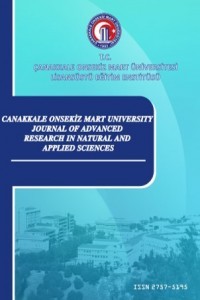Soma Linyit Kömürü, Külü Azaltılmış Soma Linyit Kömürü ve Kömür Karışımlarından Aktif Karbon Üretimi ve Karakterizasyonu
Aktif karbon, BET yüzey alanı, kimyasal aktivasyon, kömür
Production and Characterization of Activated Carbon from Soma Lignite Coal, Ash-Reduced Soma Lignite Coal and Coal Mixtures
Activated carbon, BET surface area, chemical activation, coal,
___
- Aygün, A, Yenisoy-Karakaş, S, Duman, I. 2003. Production of granular activated carbon from fruit stones and nutshells and evaluation of their physical, chemical and adsorption properties. Microporous and Mesoporous Materials; 66: 189-195.
- Bodoev, NV, Gruber, R, et. al. (1998). A novel process for preparation active carbon from sapropelitic coals. Fuel; 77 (6): 473-478.
- Chingombe, P, Saha, B, Wakeman, RJ. (2005). Surface modification and characterization of a coal-based activated carbon. Carbon; 43: 3132-3143.
- Chunlan, L, Shaoping, X, Yixiong, G, Shuqin, L, Changhou, L. (2005). Effect of pre-carbonization of petroleum cokes on chemical activation process with KOH. Carbon; 43:2295-2301.
- Cuhadaroglu, D, Uygun OA. 2008. Production and characterization of activated carbon from a bituminous coal by chemical activation. African Journal of Biotechnology; 7 (20): 3703-3710.
- Çetinkaya, S, Sakintuna, B, Yürüm, Y. (2003). Formation of crystal structures during activated carbon production from Turkish Elbistan lignite. Fuel Chemistry Division Preprints; 48 (1): 67-69.
- Durie, RA, Schafer, HNS. 1979. The production of active carbon from brown coal in high yields. Fuel; 58: 472-476.
- Ennaciri, K, Baçaoui, A, Sergent, M, Yaacoubi, A. (2014). Application of fractional factorial and Doehlert designs for optimizing the preparation of activated carbons from Argan shells. Chemometrics and Intelligent Laboratory Systems; 139: 48-57.
- Faramarzi, AH, Kaghazchi, T, Ebrahim, HA, Ebrahimi, AA. (2015). A mathematical model for prediction of pore size distribution development during activated carbon preparation. Chemical Engineering Communications; 202: 131-143.
- Hidayat, A, Sutrisno, B. (2016).Comparison on pore development of activated carbon produced by chemical and physical activation from palm empty fruit bunch. IOP Conference Series Materials Science and Engineering, 162, 012008.
- Hsu, LY, Teng, H. (2000). Influence of different chemical reagents on the preparation of activated carbons from bituminous coal. Fuel Processing Technology, 64 (1-3), 155-166.
- Jiang, B, Zhang, Y, Zhou, J, Zhang, K, Chen, S. (2008). Effects of chemical modification of petroleum cokes on the properties of the resulting activated carbon. Fuel; 87: 1844-1848.
- Jibril, M, Shawal, NN, Abbas, AZM, Dadum, HU, Musa, AM. (2014). Comparison on the characteristics of bio-based porous carbons by physical and novel chemical activation, Applied Mechanics and Materials; 554: 22-26.
- Jin, Z, Zhao, G. (2014). Porosity evolution of activated carbon fiber prepared from liquefied wood. Part I: Water steam activation at 650 to 800 C. Bioresources; 9(2): 2237-2247.
- Kawano, T, Kubota, M, Onyango, MS, Watanabe, F, Matsuda, H. (2008). Preparation of activated carbon from petroleum coke by KOH chemical activation for adsorption heat pump. Applied Thermal Engineering; 28: 865-871.
- Rashidi, NA, Yusup, S, Borhan, A, Loong, LH. (2014). Experimental and modelling studies of carbon dioxide adsorption by porous biomass derived activated carbon. Clean Techn Environ Policy; 16: 1353-1361.
- Sekirifa, ML, Mahammed, MH, et. al. (2013). Preparation and characterization of an activated carbon from a date stones variety by physical activation with carbon dioxide. Journal of Analytical and Applied Pyrolysis; 99: 155-160.
- Teng, H, Yeh, TS, Hsu, LY. (19989. Preparation of activated carbon from bituminous coal with phosphoric acid activation. Carbon; 36 (9): 1387-1395.
- Wu, FC, Tseng, RL, Hu, CC. (2005). Comparisons of pore properties and adsorption performance of KOH-activated and steam-activated carbons. Microporous and Mesoporous Materials; 80: 95-106.
- Yang, C. (2013). Preparation of activated carbon from coke powder by KOH activation. Advanced Materials Research; 616-618: 1894-1897.
- Yayın Aralığı: Yılda 4 Sayı
- Başlangıç: 2015
- Yayıncı: Çanakkale Onsekiz Mart Üniversitesi
Cybersecurity Technology Foresight: 2040 Scenarios for Turkey
Evaluation of Proteins Released to Medium in Yeast-Bacteria Co-culture System
Xception ile Histopatolojik Görüntülerden Oral Kanser Teşhisi
Analysis of Spatial Distribution of Climatic Comfort Conditions in Diyarbakır City
Vanadium Oxide Based Electrochromic Energy Storage Devices via Facile Thin Film Preparation
İki Elektronlu Atomik Sistemler için Baş kuantum Sayısı Kesir Değerli Bessel Tipli Orbitaller
Askeri Açıdan Denk Olmayan İki Ülke Savaşının Oyun Teorisi ile Modellenmesi
Murat ÖZKAYA, Ahmet BAKKALOĞLU
